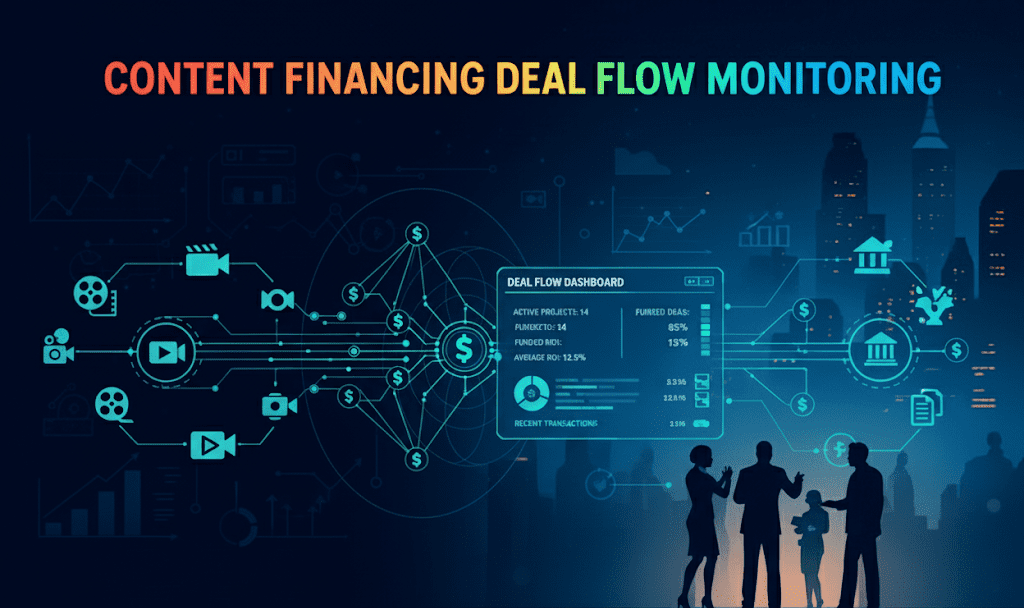The Strategic Imperative of Content Financing Deal Flow Monitoring

Introduction
The world of content financing is a high-stakes, high-risk environment. For senior executives, the ability to identify, vet, and close a deal is often the difference between a successful slate and a costly portfolio of missed opportunities.
Yet, the traditional process for managing this pipeline—the content financing deal flow—is notoriously manual and fragmented. It relies on a patchwork of personal contacts, trade announcements, and outdated spreadsheets.
The result is an opaque, inefficient system that makes it difficult to find the right projects, connect with the right partners, and gain a competitive edge.
The strategic solution is a shift toward a modern, data-driven approach: content financing deal flow monitoring. This is a practice that goes beyond simply tracking a list of projects.
It is about leveraging a centralized, continuously updated data platform to gain a holistic view of the global financing landscape, from the earliest stages of development to a project’s final greenlight. This allows executives to move from a reactive state of “who do I know?” to a proactive state of “what does the data tell me?”
Vitrina’s role is to provide the technology that makes this strategic shift possible. The platform aggregates, verifies, and connects millions of data points across the entertainment supply chain, enabling M&E professionals to execute this new, more intelligent approach to financing, co-production, and business development.
Table of content
- The Unseen Challenge: The Problem with Traditional Deal Flow in M&E
- What Is Content Financing Deal Flow Monitoring?
- The Strategic Imperative for M&E Executives
- The Role of Technology: A Look at the Vitrina Platform
- How Vitrina Transforms Deal Flow into a Competitive Advantage
- Conclusion: The Future of Deal Flow is Data-Driven
- Frequently Asked Questions
Key Takeaways
| Core Challenge | Fragmented, manual deal sourcing and vetting in the M&E sector hinders efficient content financing. |
| Strategic Solution | Adopting a data-driven, centralized system for monitoring content financing deal flow. |
| Vitrina’s Role | The Vitrina platform provides the centralized data and intelligence required to execute this strategy. |
The Unseen Challenge: The Problem with Traditional Deal Flow in M&E
The conventional approach to managing content financing deal flow is inefficient and poses significant risks. Deal sourcing is often a manual process, with executives relying on a mix of trade publications, festival attendance, and personal networks.
This provides incomplete market coverage and creates major blind spots, especially for projects originating outside of major production hubs. Without a centralized source of information, executives must spend countless hours on inefficient vetting and due diligence, manually cross-referencing information from multiple sources to understand a project’s true status or a partner’s track record.
This process is time-consuming, prone to error, and ultimately limits the volume and quality of deals that can be considered. The high cost of this reactive model is a significant challenge for an industry that demands speed and precision.
What Is Content Financing Deal Flow Monitoring?
Content financing deal flow monitoring is a strategic practice that uses technology to provide a comprehensive, real-time view of the entertainment financing landscape.
It is not simply about tracking a list of potential deals, but about leveraging a continuous flow of data to identify, qualify, and engage with projects and partners at the earliest possible stage.
A modern monitoring system for content financing must include several key components. It must have the ability to aggregate data daily from a wide range of global sources, providing real-time updates on projects as they move through the pipeline.
It must also have rich, structured metadata that goes beyond simple project titles, including details on budget, genre, territory, and intellectual property. Crucially, it must be able to link projects to the companies, financiers, and executives behind them, allowing users to map out entire networks of collaborators.
This holistic approach transforms deal flow from a fragmented, static list into a living, interconnected map of the industry.
The Strategic Imperative for M&E Executives
For senior leaders, adopting a modern content financing deal flow monitoring strategy is not a luxury, but a competitive necessity.
For Production Financiers & Co-Producers, a data-driven approach allows them to quickly find and vet relevant co-production partners aligned by genre, scale, and region, significantly de-risking new investments.
For Content Acquisition Leaders, real-time deal flow monitoring serves as an early warning system, allowing them to identify and secure pre-buy opportunities for films and series with high market potential before the competition.
Finally, for Vendor Services, this strategy is a business development accelerator. It enables them to precisely target new business leads by identifying projects at the exact stage where their services are needed and initiating conversations with the right decision-makers.
The Role of Technology: A Look at the Vitrina Platform
To execute a sophisticated deal flow monitoring strategy, a platform specifically designed for the complexities of the global entertainment supply chain is required. Vitrina is purpose-built to be that platform. It serves as a centralized, living database for the industry, offering a 360-degree view of the market.
The platform’s Global Projects Tracker is a core feature that provides real-time updates on film and television projects at every stage of their lifecycle. It automatically aggregates data from a vast network of global sources—from official industry filings and festival selections to news and market reports—to provide unparalleled visibility.
The platform’s ability to map relationships between projects, companies, and people is a key differentiator. It connects a project to its key collaborators, providing a critical layer of context that allows users to see not just what is being made, but by whom and with what resources.
Furthermore, Vitrina’s People Intelligence feature enables executives to identify and engage with the right contacts from a database of over 3 million professionals, eliminating the need for cold calls and guesswork.
How Vitrina Transforms Deal Flow into a Competitive Advantage
By centralizing and structuring global entertainment data, Vitrina transforms deal flow from a tedious, reactive task into a strategic, proactive function.
In the past, a production financier might hear about a new project and then spend weeks manually researching the production company, its key players, and its deal history.
This is a fragmented, slow, and often fruitless process. With Vitrina, this workflow is compressed and automated. The financier can set alerts to be notified the moment a new project enters development with specific criteria.
The platform instantly provides a detailed profile of the project, including its current stage, the companies attached, and a map of their past collaborations. The financier can then use Vitrina’s People Intelligence to identify the decision-maker and initiate a conversation with an informed, data-backed pitch.
This dramatically accelerates the pace of business development and increases the probability of a successful deal. Vitrina also provides crucial insights for strategic planning, allowing executives to monitor the development slates of competitors, identify emerging trends in intellectual property (IP), and track production financing models across the globe.
This level of market intelligence goes far beyond simple project tracking and provides the foundation for a smarter, more confident business strategy. You can learn more about how Vitrina’s solutions provide a competitive edge.Discover how Vitrina helps you find your competitive advantage.
Conclusion: The Future of Deal Flow is Data-Driven
The entertainment industry is at an inflection point. The traditional, analog methods of managing the content financing deal flow are no longer sufficient in a globalized, data-rich market.
The future belongs to those who embrace a strategic, data-driven approach. Content financing deal flow monitoring is the practice, and platforms like Vitrina are the enabling technology.
By providing a centralized, continuously updated source of intelligence on projects, companies, and collaborators, it empowers M&E executives to move from a state of reactive discovery to one of proactive, data-informed opportunity capture. It is the essential strategic shift for anyone serious about staying ahead in the global entertainment business.
Frequently Asked Questions
In traditional finance, deal flow refers to the continuous stream of investment opportunities that a firm or individual has the opportunity to review and potentially invest in. A strong deal flow is essential for sourcing high-quality opportunities.
Deal flow refers to the ongoing inbound stream of new potential deals. A deal pipeline is the specific, curated list of deals that are currently under active consideration or in a defined stage of the vetting and negotiation process.
A good deal flow management process involves a systematic approach to sourcing, vetting, and managing potential deals. This includes using technology to centralize data, establishing clear criteria for evaluation, and maintaining a robust, continuously updated database of contacts and opportunities.
The stages of deal flow typically include: Sourcing (identifying new opportunities), Screening (initial review), Vetting (in-depth due diligence), Negotiation (structuring the terms of the deal), and Closing (finalizing the transaction and integrating the new asset or partnership).

























